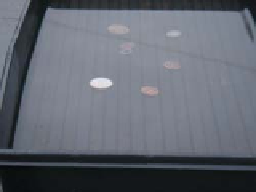Graphics Reference
In-Depth Information
p
-polarized components will no longer be one to one; instead it will be
R
s
/
R
p
.
Because in general
R
s
>
R
p
, the reflected light will be more s-polarized than
the incoming light. In fact, no matter what the mix of s- and p-polarized light
in the arriving light, the outgoing light will be more s-polarized than was the
incoming light. The same argument applies to circularly polarized light; the only
difference is one of phase, which does not enter the Fresnel equations. Incoming
circularly polarized light will generally reflect into elliptically polarized light, with
the s-component dominating.
Inline Exercise 26.7:
(a) For
n
1
=
1 and
n
2
=
1.5 (corresponding approxi-
mately to air and glass), plot
R
p
against
θ
i
, and observe that at about 56
◦
,
R
p
is 0; what does this tell you about the polarization of the reflected light when
light arrives at this angle?
(b) For any pair of materials, there's a corresponding angle; it's called
Brew-
ster's angle.
Briefly explain why Brewster's angle depends only on the ratio
of the indices of refraction of the materials.
Inline Exercise 26.8:
Consider light traveling from a piece of glass to the
air (so
n
1
=
1.5 and
n
2
=
1.0). Plot
R
s
and
R
p
against
θ
i
for 0
≤ θ
i
<
sin
−
1
(
n
2
/
sin
−
1
(
.66
)
. At the upper end of this range, the
critical angle,
both
R
s
and
R
p
are 1; all light is reflected back into the glass and none escapes
to the air. This is called
total internal reflection.
n
1
)
≈
Figure 26.15 demonstrates Fresnel's law. The first photo shows several coins
and a washer in a tray as seen from above on a calm, overcast day. The sec-
ond shows the same items, seen from about 45
◦
. So much of the incident light is
reflecting that it's much more difficult to see the items in the tray.
Figure 26.15: Fresnel's law in
action: The coins are easily
visible from overhead, but are
obscured by sky reflections when
seen at a diagonal.
The analysis above applies to insulators. For conductors, the transmitted light
is almost immediately absorbed, and the
rate
at which it's absorbed has an effect
on the reflected light. One analysis revises the index of refraction to be a
com-
plex
constant, whose real and imaginary parts correspond to the usual index of
refraction and the amount of absorption in the material, known as the
coefficient
of extinction
and denoted
. An alternative approach simply treats the refractive
index and coefficient of extinction as separate quantities. In this latter form, a good
approximation to the Fresnel reflectance for conductors (in air) is given by
κ
R
s
=
(
n
2
+
2
)cos
2
κ
θ
i
−
2
n
2
cos
θ
i
+
1
θ
i
+
1
and
(26.14)
(
n
2
+
κ
2
)cos
2
θ
i
+
2
n
2
cos
R
p
=
(
n
2
+
2
)
θ
i
+cos
2
κ
−
2
n
2
cos
θ
i
θ
i
,
(26.15)
(
n
2
+
κ
2
)+
2
n
2
cos
θ
i
+cos
2
where
n
2
is the index of refraction of the metal and
is its coefficient of extinction.
Snell's and Fresnel's laws are quite general, but there are materials whose
behavior is more interesting than that described by these equations. Calcite, for
instance, exhibits
birefringence,
in which there are
two
directions of refraction
κ













